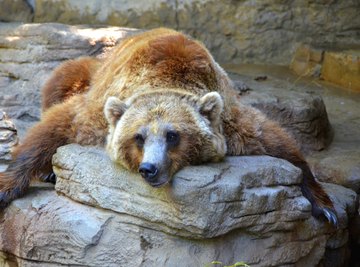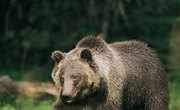
Bear hibernation is part of a bear's annual cycle of activity, when its metabolic systems change and activity pauses for a period of time varying with the habitat's climate. Grizzly bears hibernate for 5–7 months each year. But it isn't as clear-cut as curling up and going to sleep one day; the bear's metabolism eases in and out of the bear hibernation state.
Summer Hosts Normal Activity
The grizzly bear (Ursus arctos horribilis) is omnivorous, making it an apex predator, a foraging herbivore and a scavenger all at once. The North American Bear Center describes the bear's summer activity as beginning when green foliage appears, which varies by region. Its diet includes shoots, roots and berries along with the winter's die-off carrion. Bears with access to spawning runs will feast on fish, and as the International Union for the Conservation of Nature says, bear population densities vary greatly with the productivity of their environments.
In Autumn, Feeding Increases, then Slows
With the end of summer, grizzly bears enter a state called hyperphagia, in which they increase their food intake to thousands of calories per day. Parks Canada lists digging out squirrels and their nut caches as food sources. The bear's health for the year depends on the availability of food. An article in the Journal of Wildlife Management describes how the quality of the whitebark pine nut crop appears to determine the extent of bears approaching human-occupied areas, leading to higher human-caused mortality rates. As the season progresses they eat less but still drink water heavily, to purge themselves of wastes through urination.
Winter Brings Bear Hibernation
As winter approaches, the bear's metabolism begins to slow down. The National Parks Service says their heart rate can drop by half, and their breathing rate drops even more sharply. They normally excavate a new den every year, moving as much as a ton of earth over the course of a week. In Yellowstone, they often choose north-facing slopes because they tend to receive more snow, helping to seal and insulate the den. As they live off of their stored fat, the nitrogen from metabolic urea they produce is cycled back into their bloodstream to maintain their muscles.
Still in a Semi-hibernating State in Springtime
When bears emerge from hibernation, their metabolism doesn't immediately go back to summertime activity status. NABC calls this condition "walking hibernation" when, for a few weeks, bears don't eat or drink as much as in summer. NPS lists ants and dandelions as springtime foods. Bears seek winter carrion, but if opportunity permits they may also kill calves of moose, bison and elk, as well as domestic cattle and sheep. Professor Brian L. Horejsi describes how grizzly bears were eradicated from their ranges in the American Southwest in the 1800s, due to conflicts with ranching operations moving into bear habitat.
References
- ICUN Red List of Threatened Species: Ursus Arctos
- Parks Canada: Grizzly Bears
- National Park Service: Yellowstone National Park: Denning and Hibernation Behavior
- National Park Service: Yellowstone National Park: Food Habits of Grizzly Bears and Black Bears in the Yellowstone Ecoystem
- National Public Lands Grazing Campaign: Ranching in Bear Country
About the Author
An ecological blogger, technical writer and trainer, Alex Silbajoris also leads a nonprofit watershed group. He is an avid gardener and cook. He holds a bachelor's degree in English and a master's degree in journalism, from The Ohio State University. Other studies include geology and biological sciences.
Photo Credits
JRLPhotographer/iStock/Getty Images
